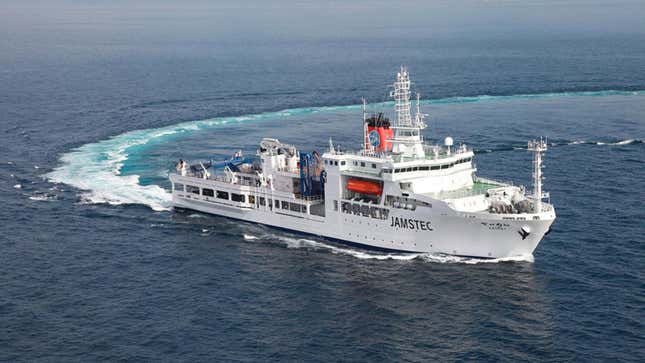
A drill aboard a Japanese research vessel has set a new record for the deepest ocean hole in history. The hole is located in the Pacific Ocean near the epicenter of the catastrophic 2011 Tōhoku earthquake, which is perilously close to Kaiju country.

Scientists aboard the research vessel Kaimei set two records on May 14, as Michael Strasser, a professor of sedimentary geology at the University of Innsbruck and a researcher with the International Ocean Discovery Program (IODP), explained in a blog post.
The drill—an elongated 130-foot-long (40-foot-long) giant piston corer—descended to a depth of 26,322 feet (8,023 meters) at a rate of 3.6 feet per second (1.1 meters per second). It took two hours and 40 minutes for the drill to reach the seafloor, but upon doing so, it established a new record as the “deepest water site drilled and cored within scientific ocean drilling history,” according to Strasser, who served as the co-chief scientist of the expedition.
The previous record was set nearly 50 years ago in the Marianas Trench of the Pacific Ocean, when a crew aboard the Drilling Vessel Glomar Challenger extracted core samples at depths reaching 23,077 feet (7,034 meters) and 23,061 feet (7,029 meters).
Upon reaching the seafloor, the drill dug down and pulled out a sample core measuring 123.9 feet (37.75 meters) long, “setting another new scientific drilling depth record for the deepest sub-sea level sample” at 26,446 feet below sea level (8,060.74 meters below sea level), Strasser wrote. The previous deepest sub-sea level sample was taken 25,374 feet (7,734 meters below sea level).
“We greatly acknowledge the tremendous efforts of the Captain and his crew to safely carry out such challenging ultra-deep water coring operations and look forward to now undertaking scientific analyses on these samples from the deepest of the deep,” said Strasser.

Unleashing gigantic aquatic monsters was not the intent. Rather, the IODP expedition researchers are hoping to glean new insights into the region’s earthquake history. The drill site, designated M0081, is located near the epicenter of the Tōhoku earthquake, as the BBC reports. The magnitude 9.1 undersea megathrust earthquake triggered a tsunami, which in turn triggered the Fukushima nuclear disaster.
This M0081 hole is deep, but it’s not the deepest. That distinction goes to the Kola Superdeep Borehole, which measures 40,025 feet (12,200 meters). That’s a depth of 7.58 miles (9.1 km), which, whoa. The Soviets created this impossibly deep hole in 1970, which they did on the Kola Peninsula northeast of Finland.
More: Discovery of living microbes deep beneath the seafloor offers hope for life on Mars.